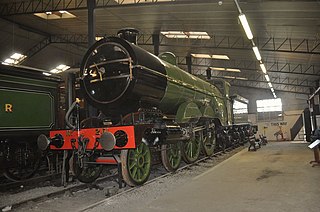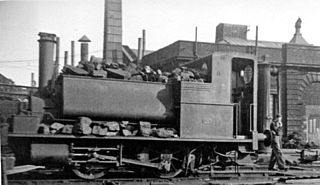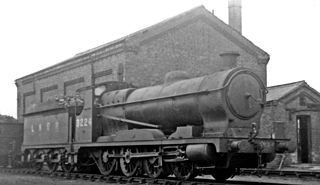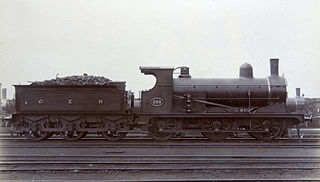
The Lincolnshire Wolds Railway (LWR) is a heritage railway based at Ludborough station, near Louth, Lincolnshire, England and the only standard gauge steam railway in Lincolnshire open to the public. The line is part of the original Great Northern Railway (GNR), a rail system that opened in 1848 and once linked Grimsby, Louth and East Lincolnshire with London. In early 2002, 2009 and 2013 the Lincolnshire Wolds Railway received a top national award from the Heritage Railway Association for its heritage railway efforts.
The London and North Eastern Railway (LNER) produced several classes of locomotive, mostly to the designs of Nigel Gresley, characterised by a three-cylinder layout with a parallel boiler and round-topped firebox. It produced the most famous locomotive of its day, 4468 'Mallard', the holder of the world steam locomotive speed record. It also built the world-famous 4472 'Flying Scotsman'. However, its locomotive inheritance was much greater than just the 'A4 Class', it also produced highly successful mixed-traffic and freight designs.

The Great Northern Railway (GNR) Small Boiler Class C1 is a class of steam locomotive, the first 4-4-2 or Atlantic type in Great Britain. They were designed by Henry Ivatt in 1897. In total 22 were built between 1898 and 1903 at Doncaster Works. The class were commonly known as 'Klondykes' [sic], after the 1897 Klondike gold rush. They could reach speeds of up to 90 mph. They were also known as Small Atlantics.

The Great Northern Railway (GNR) Class J13, classified J52 by the LNER is a class of 0-6-0ST steam locomotive intended primarily for shunting.

The Great Northern Railway Class H4 was a class of 2-6-0 steam locomotive designed for mixed-traffic work.

The Great Northern Railway Class J23 was a class of 0-6-0T steam locomotive. They had long side tanks that came to the front of the smokebox, which sloped forwards to improve visibility and had a recess cut in to aid maintenance. Forty were built by the Great Northern Railway (GNR) between 1913 and 1922, with a further 62 being added by the London and North Eastern Railway (LNER) between 1924 and 1939. They were given the nickname "Submarines" due to their long tanks.

The Great Northern Railway (GNR) Class C1 is a type of 4-4-2 steam locomotive. One, ex GNR 251, survives in preservation. Much like their small boiler cousins, they were capable of reaching speeds of up to 90 mph (145 km/h). They were also known as Large Atlantics.

The Great Northern Railway (GNR) Class O2 was a class of three-cylinder 2-8-0 steam locomotives designed by Nigel Gresley for freight work and built by the GNR from 1921. Further examples were built by the London and North Eastern Railway (LNER) from 1924.

The GER Class 209 was a class of 0-4-0 saddle tank steam locomotives of the Great Eastern Railway. These locomotives were similar to the NBR G Class but had flat-topped, instead of round-topped, tanks. A total of eight were built – four by Neilson and Company in 1874 and four more by the GER's Stratford Works between 1897 and 1903.

The Great Northern Railway Class H2 and H3 was a class of 2-6-0 steam locomotive designed for mixed-traffic work.
Willie Brayshaw Yeadon, was a British railway historian known for his magnum opus, Yeadon's Register of LNER Locomotives and other works.
The London and North Eastern Railway (LNER) operated various classes steam locomotives with a 4-6-2 wheel arrangement. The LNER operated more pacifics than any other of the Big Four British railway companies, and they were mostly used for express passenger work along the East Coast Main Line, though later in their lives many were displaced to other lines.

The Great Central Railway (GCR) Class 8A was a class of 0-8-0 steam locomotive built between 1902 and 1911 for handling heavy coal trains over the Pennines. They all passed to the LNER in 1923, who redesignated them Class Q4. They were withdrawn from service between 1934 and 1951.
The H&BR Class F2 was a class of 0-6-2T steam locomotives of the Hull and Barnsley Railway. It was designed by Matthew Stirling and nine locomotives were built by Kitson & Co. in 1901.

The Great Northern Railway (GNR) Class L1 was a 0-8-2T side tank steam locomotive designed by Henry Ivatt. It was originally designed for suburban passenger traffic on the Metropolitan City Lines.

The GER Class N31 was a class of eighty-two 0-6-0 steam locomotives designed by James Holden for the Great Eastern Railway. Eighteen passed to the London and North Eastern Railway (LNER) at the 1923 grouping and received the LNER classification J14.

The Great Northern Railway J4 Class was a class of 322 0-6-0 steam locomotives, introduced in 1882 designed by Patrick Stirling for goods traffic. Just over half of these were rebuilt by Nigel Gresley to a design by Henry Ivatt between 1912 and 1929.
The GNR Class J9 was a class of two-cylinder steam locomotives of the 0-6-0 wheel arrangement, built in 1896 for the Great Northern Railway.

The GNR Classes D2 and D3 were two classes of 51 4-4-0 steam locomotives designed by Henry Ivatt for the Great Northern Railway (GNR). They were the first 4-4-0s to be introduced by the GNR, and Ivatt's first original design for the railway as well.

The GNR Ivatt Class 1 0-6-0 was a class of fifteen inside-cylinder 0-6-0s designed for express goods work. They were Henry Ivatt's first original class of 0-6-0. Ivatt had previously designed a modified version of Patrick Stirling's J5 Class of 1873.














